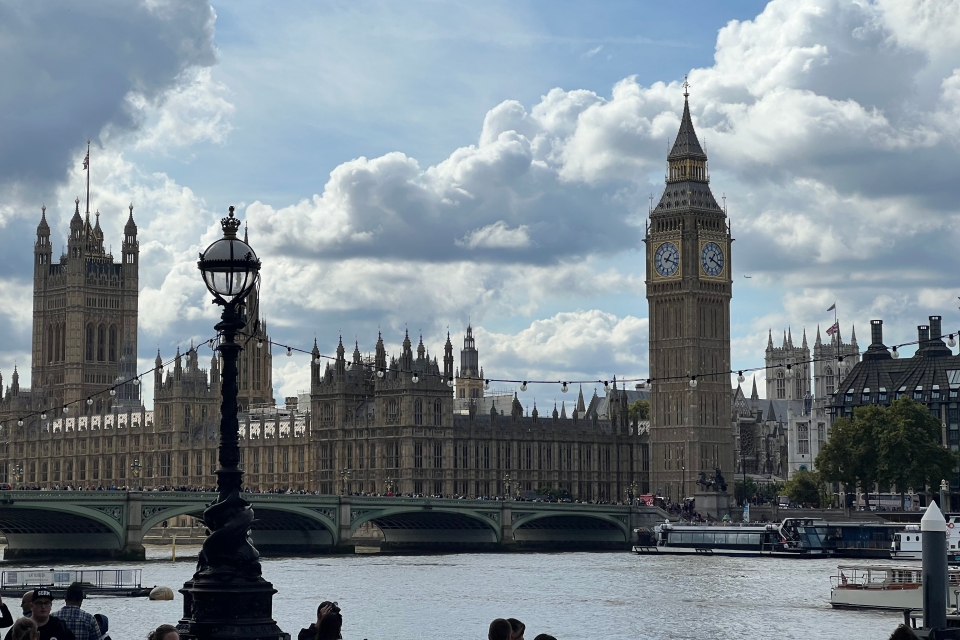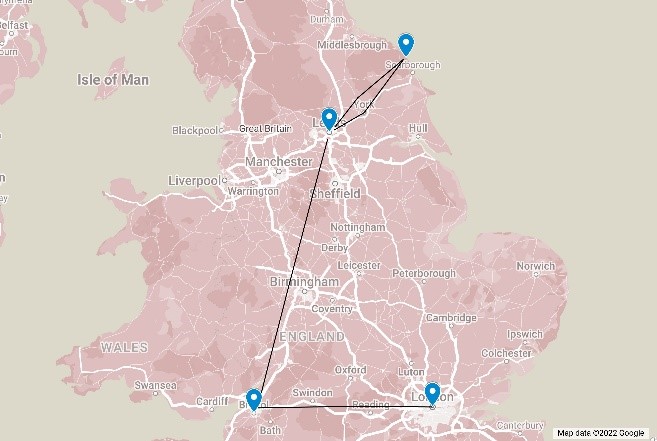
今年のテーマは“Challenge, Redesign, Flexibility”です。
Covid-19の大流行が始まって以来、4年ぶりに母国に戻り、家族に会えると思うとワクワクしました。エリザベス二世の死去、新首相の始め、ヨーロッパでの戦争、パンデミックからの復興、社会・経済問題、生活費の危機の高まりと重なった旅であった。このようなイベントや課題に直面して、物事がどのように変化したのか、もしそうであれば、それを知りたかったのです。このような変化が最も顕著に現れるのは、細かい部分であることが多いのです。

最初の1週間は地元のリーズ(Leeds)で過ごし、ヨーク(York)、スカーバラ(Scarborough)、ウィットビー(Whitby)、レイベンスカー(Ravenscar)への日帰り旅行を楽しみました。

リーズは英国で最も大きく、最も経済的に成功している都市の一つです。建設ラッシュが続き、街並みは急速に変化しています。これは、学生寮、賃貸マンション、オフィスが主な要因です。また、Royal Armouries Museum (王立武器製造所博物館)、Corn Exchange 、多くのショッピング・アーケード(新しいものと歴史的なものの両方)を訪れるのも楽しみでした。
ヨークは非常に歴史のある街で、特にローマ時代、ヴァイキング時代、中世の時代に重要な役割を果たしました。街並みは中世の面影を残し、面白いショップやスポットがたくさんあります。すべてを見渡すようにそびえ立つのは、壮大なヨーク・ミンスターというカテドラルです。

Whitby、Scarborough、Ravenscarは海岸沿いです。衰退の一途をたどっていたものの、ウィットビーやスカーバラなどの海辺の町は、海外旅行が制限されたコCovid-19のパンデミック時に観光客の増加を享受した。

次のは、私が7年間暮らしたイギリス南西部のブリストル(Bristol)です。暗い歴史を持つ街だが、のんびりとしていて、若々しく、クリエイティブな雰囲気があります。大西洋を横断する奴隷貿易の資金で建てられた優雅な都心の郊外、Clifton(クリフトン)へ小旅行に出かけました。ハーバーサイドでは、独立系レストランや店が入るコンテナパークを含むWapping Wharf(ワッピングワーフ)など、最近の開発地区をいくつか見て回りました。ブリストルではストリートアートが盛んで、市役所の支援もあり、地元住民の誇りにもなっています。

最後に、ロンドン(London)で短い時間を過ごしました。建設はそこで止まることはありません! Allies and Morrison Architectsによってマスタープランされた最近のキングスクロス再生地区には、新しいアパートメントやオフィス、大きな公共スペースがあり、私は興奮しました。また、近くにあるMae Architectsによる新しい社会住宅計画、Agar Groveも訪れました。続いてGrimshaw、BDPなどが駅を設計した新しいエリザベス線地下鉄。古い駅の分かりにくいトンネルに比べ、穏やかでシンプルな印象を受けました。最後に、コベントガーデン(Covent Garden)のショッピングとエンターテインメントの中心地にうま
くに融合したKPFの新開発、フローラルコート(Floral Court)を訪れました。
今回の旅は、新しい建物や空間のデザインだけでなく、未来向けなデベロッパー、市議会、コミュニティグループがそれぞれリスクを取り、市民にとってより良い都市にするために邁進している姿を見て、全体としてとても刺激的なものでした。
英語バージョン:
The theme for this year’s training is “Challenge, Redesign, Flexibility”.
I was excited to return to my home country and see my family after 4 years, the first time since the covid-19 pandemic started. The trip coincided with the death of Queen Elizabeth II, a new Prime Minister, war in Europe, recovery from the pandemic, social and economic issues, and a growing cost of living crisis. I was interested to see how things had changed in the face of these events and challenges, if at all. It was often in the smaller details that these changes were the most apparent.
The first week was spent in my home city of Leeds, and included day trips to York, Scarborough, Whitby, and Ravenscar.
Leeds is one of the UK`s largest and most economically successful cities. Construction was occurring at a pace, and the skyline was changing rapidly. This was largely driven by student accommodation, buy-to-let apartments, and offices. I also enjoyed visiting the Royal Armouries Museum, Corn Exchange, and the many shopping arcades, both new and historical.
York is a very historical city, important to the Romans, Vikings, and Mediaeval periods in particular. The streetscape is Mediaeval, with many interesting shops and places to explore. Looming over everything is the magnificent York Minster cathedral.
Whitby, Scarborough, and Ravenscar are on the coast. Despite being on the decline, seaside towns such as Whitby and Scarborough enjoyed a boost in visitors during the covid-19 pandemic when international travel was limited.
The next place we visited was Bristol in the southwest of England, a place I lived for 7 years. Despite its dark history, the city has a laid-back, youthful, and creative atmosphere. Our short trip took us to Clifton, an elegant inner-city suburb built on money from the transatlantic slave trade. We then walked to the Harbourside, where we saw several recent developments including Wapping Wharf, which includes a container park for independent restaurants and shops. Bristol has a strong street-art scene, which is supported by the city council and is a source of pride amongst the local population.
Finally, we spent a short time in London. Construction never stops there and I was excited to see the recent Kings Cross regeneration area master-planned by Allies and Morrison Architects, which includes new apartments and offices, as well as large public spaces. I also visited the nearby Agar Grove, a new social housing scheme by Mae Architects. The new Elizabeth Line, with stations designed by Grimshaw, BDP, etc. was next. Compared to the confusing tunnels of the older stations it had a sense of calm and simplicity. The last place on my list was Floral Court, a new development by KPF integrated beautifully into the centre of Covent Garden shopping and entertainment district.
Overall, the trip was very inspiring, not only in the designs of new buildings and spaces, but also in seeing how forward-thinking developers, city councils, and community groups have each taken risks and pushed to make their cities better places for their citizens.
